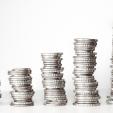Technical Stock Market Report
The good news is: The worst January since 2008 is over.
The Negatives: New lows, especially on the NASDAQ have remained uncomfortably high although well below their levels of two weeks ago.
The positives: For now, the decline in new lows suggests the rally should continue for awhile.
The chart below covers the past 6 months showing the S&P 500 (SPX) in red and a 10% trend (19 day EMA) of NYSE new lows (NY NL) in blue. NY NL has been plotted on an inverted Y axis so decreasing new lows move the indicator upward (up is good). Dashed vertical lines have been drawn on the 1st trading day of each month.
As long as NL is moving sharply upward, risk will be minimized.

The next chart is similar to the one above except is shows the NASDAQ composite (OTC) in blue and OTC NL, in orange, has been calculated from NASDAQ data.
Same pattern.

The next chart covers the past 6 months showing the SPX in red and a 40% trend (4 day EMA) of NYSE new highs divided by new highs + new lows (NY HL Ratio), in blue. Dashed horizontal lines have been drawn at 10% levels for the indicator, the line is solid at the 50%, neutral level.
Last Friday there were more new highs on the NYSE than new lows for the first time in nearly a month. NY HL Ratio finished the week at a slightly negative 39%

The next chart is similar to the one above except it shows the OTC in blue and OTC HL Ratio, in red, has been calculated from NASDAQ data.
OTC HL Ratio has not been nearly as strong as NY HL Ratio.

Money supply (M2)
The charts were provided by Gordon Harms.
Money supply growth changed direction and moved sharply downward last week.

February
Since 1963, over all years, the OTC in February has been up 57% of the time with an average gain of 0.7%. During the 4th year of the Presidential Cycle February has been up 62% time with an average gain of 2.4%. The best February for the OTC was 2000 (+19.2%), the worst 2001 (-22.4%).
The average month has 21 trading days. The chart below has been calculated by averaging the daily percentage change of the OTC for each of the 1st 11 trading days and each of the last 10. In months when there were more than 21 trading days some of the days in the middle were not counted. In months when there were less than 21 trading days some of the days in the middle of the month were counted twice. Dashed vertical lines have been drawn after the 1st trading day and at 5 trading day intervals after that. The line is solid on the 11th trading day, the dividing point.
In the chart below the blue line shows the average of the OTC in February over all years since 1963 while the black line shows the average during the 4th year of the Presidential Cycle over the same period.

Since 1928 the SPX has been up 53% of the time in February with on average no gain or loss. During the 4th year of the Presidential Cycle the SPX has been up 55% of the time with an average gain of 0.1%. The best February for the SPX was 1931 (+11.4%) the worst 1933 (-18.4%).
The chart below is similar to the one above except it shows the daily average performance over all years since 1928 for the SPX in February in red and the performance during the 4th year of the Presidential Cycle in black.

Since 1979 the Russell 2000 (R2K) has been up 59% of the time in February with an average gain of 1.3%. During the 4th year of the Presidential Cycle the R2K has been up 67% of the time with an average gain of 2.5%. The best February for the R2K 2000 (+16.4%), the worst 2009 (-12.3%)
The chart below is similar to those above except it shows the daily performance over all years since 1979 of the R2K in February in magenta and the performance during the 4th year of the Presidential Cycle in black.

Since 1885 the Dow Jones Industrial Average (DJIA) has been up 52% of the time in February with an average loss of -0.1%. During the 4th year of the Presidential Cycle the DJIA has been up 50% of the time in February with an average loss of -0.6%. The best February for the DJIA 1931 (+13.2%), the worst 1933 (-15.6%)
The chart below is similar to those above except it shows the daily performance over all years since 1885 of the DJIA in February in dark magenta and the performance during the 4th year of the Presidential Cycle in black.

Conclusion
So far this looks like a bear market rally that should last at least several weeks.
I expect the major averages to be higher on Friday February 5 than they were on Friday January 29.
Disclaimer: : Charts and figures presented herein are believed to be reliable but I cannot attest to their accuracy. Recent (last 10-15 yrs.) data has been supplied by CSI (csidata.com), FastTrack (fasttrack.net), Quotes Plus and the Wall Street Journal (wsj.com). Historical data is from Barron’s and ISI price books. The views expressed dare provided for information purposes only and should not be construed in any way as investment advice. Furthermore, the opinions expressed may change without notice.

















